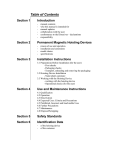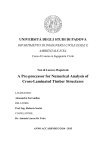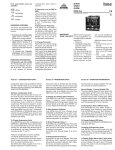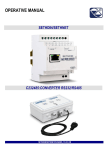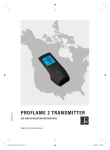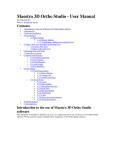Download WARM CS-CBM CABINET USER MANUAL AND MAINTENANCE
Transcript
365 WARM CS-CBM CABINET USER MANUAL AND MAINTENANCE Index 1 2 3 4 5 NORMS AND REGULATIONS.......................................................................................................... 15 1.1 Guarantee norms:.......................................................................................................................... 15 1.2 Environmental notes:.................................................................................................................... 15 1.3 Identification: ............................................................................................................................... 15 INSTALLATION .................................................................................................................................. 16 2.1 Lifting and Movement: ................................................................................................................. 16 2.2 Positioning:................................................................................................................................... 16 2.3 Environmental Specifications:...................................................................................................... 17 2.4 Electrical Connection: .................................................................................................................. 17 FUNCTIONING.................................................................................................................................... 18 3.1 Start-up: ........................................................................................................................................ 18 3.2 Command Console: ...................................................................................................................... 18 3.3 Keyboard ...................................................................................................................................... 18 3.4 The meaning of the leds................................................................................................................ 18 3.5 How to visualise and change the set point .................................................................................... 19 3.6 The ON/OFF Function.................................................................................................................. 19 3.7 Local Alarms ................................................................................................................................ 19 3.8 Stopping the Machine:.................................................................................................................. 19 MAINTENANCE .................................................................................................................................. 20 4.1 Preliminary Operations:................................................................................................................ 20 4.2 General Cleaning: ......................................................................................................................... 20 ELECTRICAL DIAGRAMS ............................................................................................................... 21 2 INSTALLATION This product must be installed by qualified personnel. 2.1 Lifting and Movement: The product is to lifted by a transport vehicle using transport pallets, in the following manner: - Position the forks at the level of the vehicle (e.g. lorry). - Move forward with the transport pallet so as to insert the forks under the cabinet. - Ensure that the cabinet is perfectly balanced on the forks before lifting it (fig.2). Fig. 2 - Position the cabinet on the ground. Lift the cabinet using the pallets as shown in figure 3. - Unscrew the screws that anchor the lists to the base (fig.3 pos. A) and remove the base (fig.3 pos. B). Proceed in the same way to remove the other base. The cabinet must be moved manually when on the ground. Fig. 3 2.2 Positioning: Please carry out the following operations to ensure correct positioning: - - Fig. 4 Position the cabinet in such a way as to leave sufficient space for use and maintenance in conditions of safety as foreseen by the UNIEN 292/2 norm point 6.2.1 and in paragraph 2.5 Ensure the existence of a suitable earthing plant as foreseen by the European Norms. Once the cabinet is placed in the desidered area, it must be put horizontally through the adjustable feets. (fig.4) 2.3 Environmental Specifications: When positioning the display cabinet remember to consider that its correct operational activity is guaranteed in temperature conditions of < 30°C and relative humidity of < 55%. Please also ensure that: - It is not exposed to direct sunlight; - The air conditioning or heating in the environment where the cabinet is positioned is not focused directly on the cabinet. It is essential to respect the aforementioned conditions in order to avoid malfunctions, which will not be covered by guarantee. 2.4 Electrical Connection: Please ensure that there is a suitable earthing plant before installation, as outlined by the current norms in the country of sale. Check that the network tension is compatible with the characteristics outlined on the plate situated on the operator’s side of the display cabinet (see fig.1 pag. 3). Also check to ensure that the line to which the cabinet is connected is of the correct dimensions to support the load of the cabinet itself. WARNING! Fluctuations in tension greater than 10% of the nominal tension indicated on the plate may cause permanent damage to the compressor and to the other pieces of electro-mechanical equipment that will not be covered by guarantee. Respect any national regulations for electrical installations. Position the general plant switch to OFF. The display cabinet is supplied with a cable with three wires; Yellow – Green = Earth Blue = Neutral Brown = Phase WARNING! Never cut or remove the aforementioned yellow-green cable for any reason. The three supply cables must be connected to the main network, which must be equipped with an efficient earthing network, in accordance with the national and local norms (where existent) for electrical installations and they must be suitable for the electrical absorption of the display cabinet. Please refer to the table in chapter 6 – Total Power Absorption column. WARNING! The electrical connection to the network must be carried out by means of the three wires included, the central plant to which the cabinet is connected must also have a switch with contact openings measuring at least 3mm and protected by fuses. WARNING! Apply an adequate anchoring method to the supply cable in the connection box, making reference to the table outlined below. NOMINAL SECTION [mm2] NOMINAL CURRENT OF THE APPLIANCE [A] 3 3÷6 6 ÷ 10 10 ÷ 16 16 ÷ 25 25 ÷ 32 32 ÷ 40 40 ÷ 63 FLEXIBLE CABLES [mm2] 0,5 0,75 1 1,5 2,5 4 6 10 ÷ ÷ ÷ ÷ ÷ ÷ ÷ ÷ 0,75 1 1,5 2,5 4 6 10 16 CABLES FOR EARTHING [mm2] 1 1 1 1,5 2,5 4 6 10 ÷ ÷ ÷ ÷ ÷ ÷ ÷ ÷ 2,5 2,5 2,5 4 6 10 16 25 3 3.1 FUNCTIONING Start-up: 1) Operate the central electrical equipment’s main switch. 2) Operate the showcase’s main switch behind the back protection board. Remove the fixing screws from the back board, as shown in picture 7 position B, and set the main switch on the “1” position (picture 7 position A) by activating the showcase’s electrical power supply. 3.2 Fig. 7 Command Console: The refrigerating plant of the display cabinet is controlled by means of an electronic console. The electronic console consists of: 1) a command console 2) a display 3.3 Keyboard T640: tastiera orizzontale a 8 tasti (185x38mm). To visualise or change the set point. When programming this button is used to select a parameter or to confirm a value. This button is used during programming for going through the parameter codes or for increasing their value. This button is used during programming for going through the parameter codes or decreasing their value. Use this button to turn the display cabinet lights on and off. Turn the instrument on and off. 3.4 The meaning of the leds There are a series of luminous points on the display, the meaning of which you will find in the table below: LED MODE ON FLASHING ON Function Heating ON Programming phase (flashing with LED ) ALARM SIGNAL - In the “Pr2” programme it indicates that the parameter is also present in “Pr1” 3.5 How to visualise and change the set point 1. Press the SET key and release it to see the set point: you will visualise the set point immediately. 2. To change the set point press the SET key and keep it pressed for 3 seconds: the led will flash ; 3. To change the value activate 4. 3.6 and . To memorise the new set point, press the SET key or wait 15 seconds to exit the programming feature. The ON/OFF Function By pressing the ON/OFF key the instrument will show “OFF”. In this configuration the loads of all of the regulations will be deactivated. To turn the instrument back ON press the ON/OFF key again. The OFF condition allows for the exclusion of the instrument from monitoring without generating any type of alarm. N.B. The LIGHT key remains active in the OFF position. 3.7 Local Alarms MESSAGE CAUSE STATE OF OUTPUTS “ P1 ” Thermostat probe failure Output according to “ Con “ and “ COF “ parameters “ HA “ High temperature alarm Unchanged “ LA “ Low temperature alarm Unchanged “ EE ” Memory anomaly “ EAL “ Digital input alarm Unchanged “ BAL ” Blockage alarm from digital input Regulation outputs deactivated Clock alarm Unchanged “ rtc “ 3.8 Stopping the Machine: To stop the machine completely, activate the switch (A) that is situated behind the back protection panel. By removing fixing screws of the back motor panel (as shown in picture 8 pos. B) it is possible to turn the main switch to “0” position (see picture 8 pos. A), thus disconnecting power supply to cabinet. Fig. 8 4 4.1 MAINTENANCE Preliminary Operations: Before carrying out any preliminary maintenance or cleaning operations you must disconnect the electricity supply by turning off the general plant switch in the room where the display cabinet is situated. 4.2 General Cleaning: - Stainless steel surfaces: Clean with a sponge or a damp cloth using water and a neutral detergent, rinse and dry off with a soft cloth. - Wooden surfaces: Clean with a sponge or a damp cloth using water and a neutral detergent, rinse and dry off with a soft cloth. - Glass surfaces: Clean with a sponge or a damp cloth using water and a neutral detergent, rinse and dry off with a soft cloth. 5 ELECTRICAL DIAGRAMS ELECTRICAL DIAGRAM TCBM The following electrical diagrams will have to be used by qualified personnel on the basis of the current regulations in vigour in the country of sale. ELECTRICAL DIAGRAM TCS






























